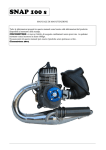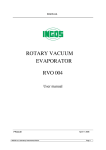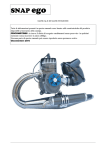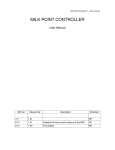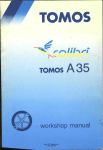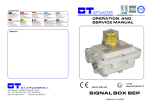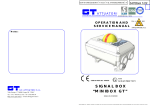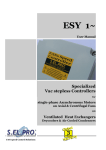Download Ciscomotors C-Max Operating instructions
Transcript
SNAP 100 MAINTENANCE MANUAL All information in this publication is based the lates product information available at the time of approval for printing. CISCOMOTORS reserves the right to make changes at any time without notice and without incurring any obligation. No part of this publication may be reproduced without written permission. Ciscomotors 2004 INDEX Pag.2 1. OPERATING INSTRUCTIONS Pag. 3 • 1.1 Basic operation Pag. 4 2. SPECIFICATIONS Pag. 6 • 2.1 Engine installation on chassis • 2.2 Tecnicals characteristics Pag. 6 Pag. 7 3. MAINTENANCE Pag. 8 • 3.1 General service information • 3.2 Routine cleaning • 3.3 Maintenance schedule Pag. 8 Pag. 8 Pag. 9 4. STORAGE Pag. 10 5. SPARE PARTS & EQUIPMENT Pag. 11 • 5.1 Spare parts • 5.2 Equipment Pag. 11 Pag. 12 6. ASSEMBLY/ DISASSEMBLY Pag. 13 • • • • • Pag. 13 Pag. 14 Pag. 20 Pag. 21 Pag. 22 6.1 6.2 6.3 6.4 6.5 Carburettor Termical Group Starter Silencer Sponge filter 7. CARBURATION REGULATIO Pag 23 8. TROUBLESHOOTING Pag. 24 9. TORQUE VALUES ENGINE Pag. 25 Pag.3 1. OPERATING INSTRUCTIONS FUEL • Snap 100 has a two-stroke engine that requires a gasoline-oil mixture. • Use gasoline with a pump octane number of 92 or higher .if “knocking” or “pinging” occurs, try a different brand of gasoline or a higher octane grade.. • Premix gasoline and oil in a ratio of 40:1. Prepare the fuel mixture in a clean container fig.1 , and shake unitl throughly mixed before filling the fuel tank. • USE A GOOD QUALITY OF SYNTHETIC 2-STROKE OIL CAUTION: To much oil will cause excessive smoking and spark plug fouling. Too little oil will cause engine damage or premature wear. Mix fuel in a ratio of 40 parts gasoline to 1 part oil (40:1) • Vegetable oils separate from gasoline more easily than mineral oils, especially in cold weather. It is advisable to use synthetic oil. CAUTION: • Do not mix vegetable end mineral based oils. WARNING • Gasoline is extremly flamable and is esplosive under certain conditions. Perform this operation in a wellventilated area with the engine stopped. Do not smoke or allow flames or sparks in the area where gasoline is drained or stores and where the fuel tank is reflued. fig.1 FUEL 92/98 octane Sintetic oil liters cl 0,5 1 2 3 4 5 10 0,125 0,25 0,50 0,75 10 1,5 25 Pag. 4 1.1 BASIC OPERATION • In the 2-stroke motors like the Snap100, is of absolute importance the corrected carburation to avoid seizure to the piston (not covered from guarantee). Start the Engine WARNING • Never run the engine in an enclosed area. The exhaust contains poisonous carbon monoxide gas that can cause loss of consciousness and may lead to death. • Attempting to start the engine without the riducer provokes the outbreak of the clutch and can cause injury or damages. • Never run the engine in an without propeller. • The starter attempt can carry to the spin of the propeller and therefore to possible lesions. • The motor in run emits disturbs electromagnetic. Warm Engine Starting: 1. To appeal the starter and to delicately pull hardly after the harder point 2. To pull the grip with energy, without throttle in. Stopping The Engine 1. Depress and hold the engine stop button until the engine stops completely Break-in Procedure : Following proper break-in procedure helps censure that some of the most important and expensive components on your new Snap100 will provide maximum performance and service life. (Also follow proper break-in procedure for a newly rebuilt engine) Cold Engine Starting: 1. Do not hold the throttle in one position for more than a few 1. To carry in pressue the circuit of seconds. It’s a better to roll the the gasoline, to help itself throttle on and off, without gain pressing the push-button (fig.2). too height and force too much a 2. To appeal the starter and to motor delicately pull hardly after the 2. Use the motor for features of 10 harder point (to try repeatedly for minute to the time and to leave to being sure). cool it. 3. To pull the grip with energy, 3. After two hours of I use or without throttle in. . approximately 10 liters of 4. In case of lacked starter to repeat gasoline the motor you have the procedure without to ended the break.accelerate . 4. This same procedure should be 5. Allow the engine to warm up for followed each time at least 2 minutes before riding off, preferably until the side of the • Piston is replaced cylinder is very warm to the touch • Cylinder is replaced through your riding glove. Slowly • Crankshaft or crak bearings are replaced increase rpm and don’t blip the trottle warning the engine is important to prevent cold seizures Pag. 5 Fig.2 Pag. 6 2. SPECIFICATIONS 2.1 ENGINE INSTALLATION ON CHASSIS Fig.3 1. Engine stop connector 2. Throttle cable 4. Support engine 5. Manual starter CAUTION: To use antivibrating of optimal quality not superior 70s 3. Propeller Pag.7 2.2 TECHICALS CHARATTERISTICS Motor SNAP 100S Type Disposition cylinder Bore max Stroke max Displacement Compression ratio Maxim Power Max Torque Lubricating Electrical sistem Ignition Rotor Spark plug standard Winter spark plug Starter Carburettor Type Walbro* Setting screw min Walbro* Setting screw max Trasmission Clutch Type Reduction Reduction ratio Exhaust Type Silencer Support engine Type *The standard carburation Temperature 10°c P 1024 Mb UR 50% Altitude (S.L.M.) 50 m 2 times cooled to air Monocylinder vertical 51mm 47mm 96 cc 11,2 : 1 12,5 kw (17cv) 9000 turns 14 Nm 8800 turns 20cc Elettronic ignition Variable Advance Ngk br9hs Ngk br8hs Manual Walbro wb32(Ciscomotors) / Dell’orto 1/4 4/5 Centrifuge 3 shoe Gears helicoidal 1,63 Expansion Chamber Glass wool N.4 silent-block Pag. 8 3. MAINTENANCE 3.1 GENERAL SERVICE INFORMATION: • To wear gloves and glances when you make the maintenance; • Do not perform maintenance while engine is running. Injury to your fingers, hands or head may result ; • Perform maintenance on firm, level ground, using hard workstand, and not directly on chassis; • Always install new gaskets, o-rings, piston pin clips, snap rings ect..wen riassembling • When tightening bolts, nuts or screw, start with the larger diameter or inner fasteners, and tighten them to the specified torque using a criss-cross pattern; • Use genuine Ciscomotors parts when maintenance your Snap100 • Clean parts in non-flammable cleaning solvent when disassembling. Lubricate any sliding surface, O-rings and seals before reassembling. WARNING Gasoline or low flash point solvents are highly flammable or explosive and must never be used for cleaning parts . Fire or explosion could result. • After reassembling, chek all parts for proper installation and operation NOTE: • Specification are listed chapter 2. 3.2 ROUTINE CLEANING • If the SNAP100 were only little dirty to clean up it with clean dusts cloth without dissolvents • If the SNAP100 were much dirty to clean up it with biodegradable detergents and not with dissolvents, lubricate where is nececessary. Pag. 9 3.3 MAINTENANCE SCHEDULE FREQUENCY INSPECT REPLACE Before and after each use All screw nuts, bolts correctly tigthen, silent-block in. Every 100 hours Cylinder head decarbonizing and cleaning sponge filter Complete piston Every 200 hours Diameter clutch, usury of the bell clutch, and glass wool of the silencer Each year All rubber and plastic components. Crankshaft bearing ,bearing reducer, oil reducer, crankshaft seals, thermical group, connecting rod. Fuel diphragms of carburettor , spark plug. Pag. 10 4. STORAGE Extended storage such as for winter, requires that you take certain steps to reduce the effects of deterioration from nonuse of your Snap100. In addition necessary repairs should be made BEFORE storing your Snap100: otherwise these repairs and clean may be forgotten by the time your Snap100 his removed from storage. . Pag. 11 5. SPARE PARTS & EQUIPMENT 5.1 SPARE PARTS COD. DESCRIZIONE 000001.0 000002.0 000003.0 000004.0 000005.0 000006.0 000006.1 000006.2 000007.0 000008.0 000009.0 000010.0 000011.0 000012.0 000013.0 000014.0 000015.0 000016.0 000017.0 000018.0 000019.0 000020.0 000021.0 000022.0 000023.0 000024.0 000025.0 000026.0 000027.0 000028.0 000028.1 000028.2 000029.0 000030.0 000030.1 000030.2 000031.0 000032.0 000033.0 000034.0 000035.0 000036.0 000037.0 000038.0 000039.0 SPARK PLUG CUP SHAFT SPARK PLUG CARBON FIBER COOLING AIR DUCT WIRE LEADS/CAP SCREW SILENT-BLOCK MOTOR SPARK PLUG NGK B8HS SPARK PLUG BR8HS SPARK PLUG NGK BR9HS CYLINDER HEAD CYLINDER HEAD NUTS/ WASHERS CYLINDER HEAD SPECIAL NUTS/WASHER NUTS/WASHERS OR CYLINDER HEAD CYLINDER STUDBOLT CYLINDER STUDBOLT EXHAUST EXHAUST NUTS/WASHER GLASS WOOL PISTON COMPLETE PISTON RING NEEDLE BEARING CRANKSHAFT CONNECTING ROD BEARING OIL SEAL CRANKCASE ENGINE REED VALVE PIPE DEPRESION CARB THROTTLE BRACKET/CAP SCREW MANIFOLD INTAKE WB32 MANIFOLD INTAKE TRITON MANIFOLD INTAKE DELL’ORTO CAP SCREW CARBURETTOR WB32 CARBURETTOR TRITON CARBURETTOR DELL'ORTO FILTER BAND CAP SCREW FLANGE CARBURETTOR AIRBOX FILTER IGNITION COIL CAP SCREW COIL KEY WOODRUFF BOLT AND NUT OPZ OPZ OPZ OPZ OPZ OPZ COD. DESCRIZIONE SCREW GRAFT STARTER 000040.0 COOLING FAN 000041.0 000042.0 OPZ PROPELLER 1250 TIPE.GT CAP SCREW COOLING FAN 000043.0 SPRING STARTER 000044.0 GRAFT STARTER 000045.0 IGNITION COMPLETE 000046.0 IGNITION CRANKCASE COVER 000047.0 CAP SCREW 000048.0 NUT SCREW GRAFT STARTER 000049.0 MANUAL STARTER 000050.0 PULLEY STARTER 000051.0 CHORD 3,5 m/m 000052.0 HANGRIP STARTER 000053.0 SPRING MANUAL STARTER 000054.0 REDUCER 000056.0 CLUTCH 000057.0 CAP SCREW 000058.0 CAP SCREW REDUCER 000059.0 PAIR GEAR 000060.0 BEARING 000061.0 BOLT AND NUT 000062.0 CLUTCH BELL 000063.0 CRANKCASE REDUCER 000064.0 SILENT-BLOCK EXHAUST 000065.0 BOLT AND NUT 000066.0 EXAUST-PIPE EXPANSION 000067.0 SPRINGS EXHAUST 000068.0 SILENCER 000069.0 PROPELLER HUB 000070.0 RUBBER DISK 000071.0 PROPELLER FLANGE 000072.0 CAP SCREW HUB PROPELLER 000073.0 WASHERS HUB PROPELLER 000074.0 CAP SCREW 000075.0 CAP SCREWS SET CRANKCASE ENGINE 000076.0 CYLINDER GASKET 000077.0 EXHAUST GASKET 000078.0 MAINFOLD IMMISSION GASKET 000079.0 CARBURETTOR GASKET 000080.0 REDUCER GASKET 000081.0 MUFFLER BAND 000082.0 Pag.12 5.2 EQUIPMENTS COD 100.200 100.201 100.300 100.301 100.302 100.310 100.311 100.312 100.315 100.316 100.320 100.321 100.325 100.330 DESCRIPTION FLYWHEEL CLUTCH FLYWHEEL BELL CLUTCH SOCKETS HEX 17 m/m SOCKETS HEX 11 m/m SOCKETS HEX 10 m/m MALE EXAGON KEY 3m/m MALE EXAGON KEY 4m/m MALE EXAGON KEY 5m/m SCREWDRIVERS-BLADE 1XL SCREWDRIVERS PHILLIPS 1-2 HUMMER PLASTIC HEAD PLIERS FOR SPRINGS TORQUE WRENCH PRESSURE GAUGE CARBURETTOR Pag.13 6. DISASSEMBLY/ASSEMBLY WARNING Modification of the motor, or removall of original equipment may make the motor unsafe. 6.1 DISASSEMBLY CARBURETTOR This section covers maintenance of the carburettor. • Repalce diaphragm fuel pump 1. Remove the 4 screw (Fig.4) 2. Remove the diaphragm 3. Clean the filter 4. To replace the diaphragm with a new one. (Fig.5) Fig.4 5. Install the cover and tighten the screw to spefied torque TORQUE: 4Nm (0.4 Kgf/m) Fig.5 Pag.14 6.2 DISASSEMBLY TERMICAL GROUP This section covers maintenance of the cylinder and piston. These service can be done with the engine installed in the frame.The cylinder has a nicasil coating and cannot be rebored. If it is demaged, it must be replaced. Before disassembling, clean the engine througly to keep dirt from entering the engine.Remove any gasket material from the mating surfaces. Do not use a screwdriver to remove the cylinder head. Clean all parts before inspecting. Before assembling, apply clean 2 stroke engine oil to all sliding surfaces. 1. Disassembly the motor from the chassis 2. Disconnect the spark plug cap 3. Remove the spark plug 4. Remove 3 caps screw and the cooling air duct Fig.6 5. Remove 2 bolts and nuts exhausts fixing (fig.6) 6. Remove 2 springs (Fig.7) Fig.7 Pag.15 7. Pull the exhaust with resolution (Fig.8) * Apply silicon gasket higt temperature. Fig.8 8. Remove the 4 cylinder head bolts and nuts (Fig.9) Fig.9 9. Remove the cylinder head o-ring gasket (Fig10) Fig.10 NOTE To avoid warping the cylinder head, use a criss-cross pattern to loosen each nut about ¼ turn, then remove the nuts. Pag.16 DISASSEMBLY PISTON 10. Remove the piston pin clips using a pair of needle-nose pliers (Fig.11) Fig.11 11. Press the piston pin out of the piston and remove the piston.(Fig.12) Fig.12 12. Spread each piston ring end remove by lifting it up a point just oppisite the gap (Fig.13) Fig.13 CAUTION: do not damage the piston ring by spreading the ends too far. Pag.17 Decarbonizing COMBUSTION CHAMBER Remove the carbon deposits from the combustion chamber. Clean the head gasket surface of any gasket material CAUTION: Use care not to scratch the combustion chamber or the head gasket surface. CYLINDER Clean carbon deposits from the exhaust. CAUTION: Do not damage the cylinder bore. INSTALLATION PISTON 1. Install the piston rings like (Fig.14) 2. Lubricate the piston rings and piston ring grooves with clean 2 stroke oil 3. Install the piston with the sign turned towards the exhaust (Fig.15) 4. Install the piston pin (Fig.12) Fig.14 5. Install the piston rings on the piston (Fig.11) Fig. 15 CAUTION: • Use new pin clips. Never use old clips • Do not let the clips fall into the crankcase. Pag18 INSTALLATION CYLINDER 6. Install the new cylinder gasket 7. Allign each ring and gap with the piston ring pins in the ring groves (Fig.16) Fig. 16 8. Lubricate the piston with 2-stroke oil 9. Slip the cylinder over the top of the piston while compressing the rings. (Fig.17) Fig. 17 10. Then, install the cylinder on to the crankcase Pag. 19 INSTALLATION CYLINDER HEAD 1. Install the new cylinder head gasket o-ring (Fig.10) 2. Install the cylinder head and nuts (Fig.9 ), tighten the nuts to the specifed torque. TORQUE : 12Nm( 1,2 kgf/m) NOTE: Tighten the cylinder head nuts in a criss-cross pattern in 2 or 3 steps INSTALLATION EXHAUST 1. Insert the antivibrating pins thread in the support exhaust (Fig. 6) 2. Pull the exhaust with resolution and insert the spherical entrance on the cylinder (Fig. 8 ) 3. Install the springs (Fig.7) 4. Tighten the 2 bolts and nuts to specified torque (Fig.6) TORQUE: 10Nm( 1 kgf/m) INSTALL COOLING AIR DUCT 1. Replace the cooling air duct on the cylinder head 2. Tighten the 2 crankcase cap screw, and then the cylinder head cap screw to the spcified torque TORQUE: 8Nm( 0.8 kgf/m) INSTALLATION SPARK PLUG 1. Lubricate the sparks plug thread 2. Tigthen the spark plug to the specified torque TORQUE : 18Nm( 1.8 kgf/m ) 3. Install the spark plug cap. Pag. 20 6.3 DISASSEMBLY/ASSEMBLY STARTER 1. Remove the air duct see the chapter 6.2 2. Remove 4 screw (Fig.18) 3. Remove the bolt (Fig.19) 4. Remove the pulley CAUTION NOT REMOVE THE SPRING (fig.21) 1. Install the pulley and tighten the screw (Fig. 19) to the specified torque TORQUE : 10Nm( 1 kgf/m) Fig.18 2. Insert the starter into the cooling fan with open grafts (Fig.20) 3. Tighten the screw (Fig.18) to the specified torque TORQUE: 6Nm( 0.6 kgf/m) Fig.19 Fig.20 Fig.21 Pag. 21 6.4 DISASSEMBLY/ ASSEMBLY SILENCER 1. Remove the exhaust like chapter 6.2 2. Remove the 3 bolts and cap screw fixing silencer (Fig,.22) 3. Remove the glass wool 4. Remove the carbon deposite from the inner pipe using the wire brush 1. Repalce the glass wool 2. Install the new glass wool packing material, opening the incision of the glass wool NOTE : be carefull not to damage the glass wool 3 . Tighten the 3 bolts and cap screw to the specified torque TORQUE : 12Nm( 1,2 kgf/m) Fig.22 Pag.22 6.5 DISASSEMBLY/ASSEMBLY SPONGE FILTER 1. Unscrew the filter band (fig.23) 2. Remove the airbox from the motor 3. Remove 4 screw (Fig.24) 4. Remove the sponge filter (Fig.25) Fig.23 5. Cleaning with biodegradable detergents (don’t use gasoline)and dry the sponge filter. 6. Lubricate the sponge filter.(Fig.25) 7. Assembly all of the airbox CAUTION INSTALL THE SECURITY CABLE (fig.23) Fig.24 Fig.25 * Foam filter , help combat the ingress of sand and dust repels water without affecting engine breating. Only apply to clean, dry filter. Ensure complete penetration and coverage. Allow to dry before refitting. (Fig.25) Pag.23 7. CARBURATION REGULATION 1. Regulation throttle cable 2. Regulation Min. gasoline 3. Regulation Max gasoline Fig.26 Standard regulation In case of problems of wrong carburetion , repalce the originals levels. Screw regulation of min. 1/4 turns from all closing. (Fig.26 point 2) Screw regulation max. remove 4/5 turns from all closing. (Fig.26 point 3) Attention the carburation regulation must be made at warm motor. To execute in sequence the below operations: 1. 2. 3. 4. 5. To regulate the screw of the max. to 4/5 of turn; (Fig.26 point 3) To regulate the screw of the min. to 1/4 of turn; (Fig.26 point 2) To fill up the circuit of feeding with the appropriate pomp; To start the motor without accelerate (the motor must set off); To reduce the passage holes air of the filter airbox with one hand, in order to hold the rich carburation for some second ones; 6. To warm the motor for 4 or 5 minute to the regimen of spin of 4000 rpm; 7. To regulate the screw of the minimal jet, to put the motor to 5500 rpm, to screw or to unscrew the screw until when the motor turns cleaned up and does not mutter; 8. To leave the motor for some second ones at minimum, to riaccelerate brusquely, now the motor must quickly accelerate without to mumble or to come less. Attention the turn screw is many sensitive (1/4 regulation standard) 9. To regulate the lessened motor spin de of 2000/2200 rpm. (Fig.26 point 1) When very regulated the carburetor does not need of ulterior regulations, but in the case in which it takes place a change of altitude (1000 meters) Pag.24 8. TROUBLESHOOTING 1. THE ENGENE DOES NOT START OR IS HARD TO START CHECK Check if fuel is jetting to the carburettor POSSIBLE CAUSES SOLUTION No fuel in tank Fill tank per fueling Clogget fuel line or fuel filter Replace and clean Diaphragm fuel pomp broken Replace the diaphragm (fig .27) The engine stop switch is to ON Move it on OFF Try spark test Faulty spark plug Replace Broken or shorted inition coil Replace 2. ENGINE LACHS POWER CHECK POSSIBLE CAUSES SOLUTION Fuel air mixture to lean Tourn the screw max out (fig.26 punto 3) Fuel air mixture to reach Tourn the screw max in (fig.26 punto 3) Clogget fuel line or fuel filter Replace and clean Diaphragm fuel pomp broken Replace the diaphragm (fig.27) Check the carburation Pag.25 3. THE ENGINE VIBRATES EXCESSIVE CHECK POSSIBLE CAUSES SOLUTION Exessive wear, holder rubber Repalce (Max 70 Sh) Prop out of balance Balance or replace Silent-block engine 9. TORQUE VALUES ENGINE ITEM Cap screw propeller hub Spark plug Cap screw cooling air duct Cap screw crankcase starter Bolt cylinder head Cap screw riducer/engine Cap screw crankcase reducer *Bolt Dado clutch bell *Bolt clutch All bolts *Bolts ignition * Apply locking agent Thread diam x pitch Torque gf*m M 6 x 1,0 M14 x 1,25 M 5 x 0.8 M 5 x 0,8 M 7 x 1,0 M 6 x 1,0 M 6 x 1,0 M 10 x 1.25 M 10 x 1.25 M 6 x 1,0 M 10 x 1.25 1.2 1,8 0,6 0,6 1,2 1,1 1,2 3,8 3,8 0,9 4,0

























